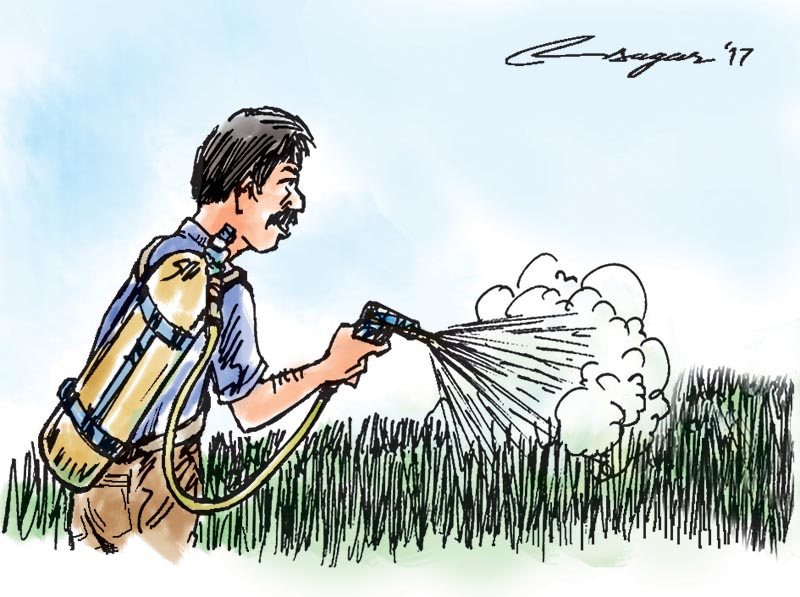Risk of pesticide: Exercise caution
The washing of the vegetables and fruits three times reduces the residue by 60-70% and dipping of agricultural produce in vinegar or salt for 15 minutes before cooking followed by thorough washing can reduce the residue by 70-80%
With the pace of commercialization in the agriculture sector of Nepal, the application of pesticide has been raised rapidly in a rampant way to control the incidences of pests and disease outbreaks.
Though application of the pesticide controls the pest problems to some extent in the long term it brings lots of problems like pest resistance, minor pest outbreak and soil, water contamination. Increasing the use of pesticide in the field crop is not the ultimate solution, rather, developing the sustainable approach toward pest management, like integrated pest management (IPM), can be the best way.
In Nepal for the first time a pesticide act and pesticide regulations were enacted in 1991 and 1993 respectively. Plant Protection Directorate (PPD) initially took over the role of pesticide registration and management. Since 2004, a full fledged Pesticide Registration Office is operational.
A Plant Protection Officer in each district (total 75) is designated as a pesticide inspector. Yet, the main challenge that remains for the government and the concerned sector is the prevailing little awareness of the farmers about specific pesticide use, their safe handling and disposal procedure, direction of use and illegal marketing.
Most of the farmers take pesticide as medicine that is used to cure crops from diseases and pests. But actually it is the toxic materials that either kill or deteriorate the growth of the pests increasing the yield of crops. In the market a wide range of pesticides are available.
Among them some of them like persistent organic pollutants (POPs) have comparatively high residual effect which consequently creates health hazards due to the accumulation of the pesticide residue in different tropic levels of the eco-system. They persist for a long time in the environment and cause environment problems.
The major problems that are prevalent in our community can be categorized into two classes. One is the lack of awareness among the farmers about the proper use of the pesticide and next is the lack of systematic marketing and monitoring system.
According to the Plant Protection Directorate(PPD, 2015), 8551 resellers (agro-vet) have received training on safe use of pesticides and storage management, of which 3493 license holders have been selling the pesticides through agro-vets. Pesticides are sold not only by the agro vets, they are even sold by other shopkeepers.
Because of this our farmers are not able to get specific pesticide for the specific pest and disease, effective direction of use and other proper mentorship. Improper handling and storage, improper transport and unsound disposal methods are the major practices that consequently lead to pesticide misuse. Similarly, the illegal marketing of the banned pesticides like Monocrotophos, Methyl Parathion, Endosulfan DDT, Aldrin, made the condition more severe.
The study carried out by the IUCN in 1995 reported the national average use of chemical pesticides as 142 gm a.i. /ha which leaped to 396 gm a.i./ha in year 2015 as per the plant protection directorate. A Plant Protection Directorate report 2073/74 reveals that some of the food crops imported from Kavre, Dhading, Kathmandu, Chitwan, Parsa, Sindhupalchowk, Bara contain excess pesticide residue and are not safe to use.
The Kalimati Fruits and Vegetable Market Development Committee’s (KFVMDC) is the only unit to detect the residue in vegetables and other food crops whose year-wise compilation of rapid bioassay of pesticide residue (RBPR) analysis reveals that in the year 2071/72, among the total of the 1570 tested samples; 15 samples are in the stage to need quarantine and 4 samples are not safe for consumption and were thus disposed. While reviewing the statistics of the 2073/74 of the total 1903 tested samples, 5 needed quarantine and 22 samples needed to be disposed. This scenario depicts the increasing risk to consumption of agriculture produce containing high pesticide.
A research carried out by the Center for Eco-genetics and Environmental Health, University of Washington reported that “Fetuses, infants, growing children, pregnant and nursing mothers, and women of childbearing age are most at risk from adverse health outcomes from exposure to pesticides. Children are more at risk than adults because children eat more relative to their body weight than adults eat.” Our farmers and consumers need to know good agriculture practices (GAP) and the government should focus to strengthen its extension services to the community level.
Use of the indigenous knowledge and practices like using ash, cattle urine, neem powder, etc must be promoted with possible scientific manipulation to strengthen the efficacy of indigenous practices. Use of bio-pesticide and other environmental friendly means are alternatives. For example, washing vegetables with water for one minute at room temperature results in approximately 40 to 90% reduction of the levels of the pesticides originally detected on the produce.
Similarly, washing of the vegetables and fruits three times reduces the residue by 60-70% and dipping of agricultural produce in vinegar or salt for 15 minutes before cooking followed by thorough washing can reduce the residue by 70-80%. These types of practices must be communicated to the entire consumers via the social media.






